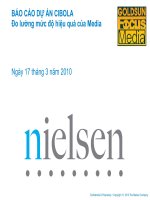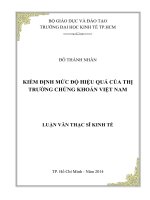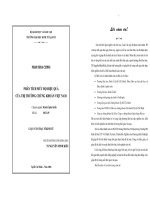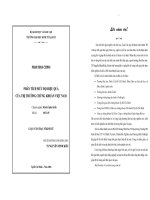Mức độ hiệu quả của việc nâng cao trình độ nghe hiểu tiếng anh của sinh viên qua các ứng dụng trên điện thoại so với qua các kênh trên youtube
Bạn đang xem bản rút gọn của tài liệu. Xem và tải ngay bản đầy đủ của tài liệu tại đây (1.02 MB, 7 trang )
TẠP Cli CÚNG TiưdNC
THE EFFECTIVENESS OF USING MOBILE
APPLIC ATIONS VERSUS YOUTUBE
CHANNELS ON ENHANCING STUDENTS’
LISTENING COMPREHENSION SKILLS
• TRAN THI LE TH UY
ABSTRACT:
This study aimed to find out whether English learning mobile applications or Youtube
channels could help students improve their listening comprehension skills better. Online study
during Covid-19 has led to a demand to discover a wide variety of ways to adapt the situation.
A number of tools has been tested to apply virtual teaching and learning. The experiment was
conducted at the two classes of the course Listening 1 at Van Lang University. The participants
were divided into two groups: the first group was conducted with top most subscribed English
learning Youtube channels; the other was carried out with highest ranking English learning
mobile applications. The pre-test and post-test administered at the beginning and at the end of
the experiment. Then the scores of the two classes were collected and the data was statistically
analyzed. A questionnaire was delivered to the students afterwards to collect more ideas
about the methods. The study shows positive gains for the two experimental group students’
outcomes as a result of the integration of mobile applications and Youtube channels. Thus,
it was recommended that both means of learning should be considered as an efficient tool in
integrated skills.
Keywords: online learning, mobile applications, YouTube channels, listening skills.
1. Introduction
Listening course is quite a big obstacle for
Vietnamese students in general due to the lack of
practicing these skills since their high schools. It is
even more challenging for them to study listening
skills online, which means the students have to spend
more time with their devices studying themselves.
Fortunately, with the development of technology
and digital network environment, students can
easily access to a great number of available software
for their needs of study. In reality, the application of
hi-tech on language learning has been worldwide
adopted effectively. The broad use of smart phones
and different transportable and Wi-fi gadgets has
converted the traditional teaching method and
learning process (Kukulska-Hulme, 2009).
174 So 14-Tháng 6/2021
This study aimed to find out whether English
applications or YouTube channels could help
students improve their listening skills better. To
achieve the above purpose, the study sets up the
following research questions:
(1) Can English applications and YouTube
channels help first-year English majored students
improve their listening comprehension skills?
(2) To what extent do English applications and
YouTube channels help the students improve their
listening comprehension skills?
2. Literature review
2.1. Online learning
According to Cojocariu et al. (2014), online
learning is the competence in using a computer
QUẢN TRỊ QUẢNLÝ
connected to a network to learn anywhere and
anytime. Online learning makes the learning
process more innovative and more flexible.
Students can learn independently and interact
easily with teachers their peers (Singh & Thurman,
2019). Online platforms are beneficial to students
because of accessible video conferences with large
capacity, live forum discussions, high speed internet
connections, online lessons on computers and also
mobile phones, possibility of watching recorded
lectures, instant feedback from both teachers and
students, and taken assignments (Basilaia et al.,
2020).
2.2. Listening comprehension skills
Bingol M. (2014) finds that some difficulties
students may have in listening comprehension
include: (1) quality of recorded materials, (2)
cultural differences, (3) accent, (4) unfamiliar
vocabulary, (5) length and speed of listening, (6)
physical conditions, and (7) lack of concentration.
Therefore, a variety of methods has been considered
to support students in their listening comprehension
practice. Djabborova, F. (2020) suggests some
effective methods that can solve the problems are
mock interview, authenticity, and other resources
video tools, including short sketches, films, and
dramatic and comedic materials.
2.3. The use of mobile applications for lan
guage learning
As defined in Cambridge dictionary, mobile
application (apps) is a software program that runs on
a mobile phone. Among the numerous apps, there is
a large number of apps relating to English learning.
These apps can be easily and freely downloaded by
students according to their own levels and interests.
As a matter of fact, the applications to improve
learners’ ability and motivation have attracted much
notice of many researchers. The features of mobile
technology such as portability and information
accessibility play a major role in the enhancement of
English language teaching and learning (El-Hussein
& Cronje (2010)). Liu & Xuan He (2014) assert that
Mobile-Assisted Language Learning (MALL) can
not only enhance students’ English ability but also
increase students’ learning motivation. It is helpful
and efficient for college students using mobile
devices to learn English by themselves.
2.4. The use of channels on Youtube for
language learning
YouTube, which started in 2005, is classified as
the third most visited website on the Internet (Alzyoud & Kabilan, 2012). This site is considered as
a huge library for English educators with a number
of ways of ranking. Alimemaj (2010) mentions that
YouTube videos help students practice their verbal
communication and listening skills. Obviously,
authentic videos can be some of the best resources
for learning English. For example, learners can hear
how the words are spoken, helping them to improve
their pronunciation and listening skills. At the same
time, they can see the words or images on screen,
which is perfect for a “visual” learner. Moreover,
the best videos are also interesting and fun to watch,
which makes the information easier to remember.
YouTube is also a free-of-charge resource for EFL
videos and there are thousands of different channels
to choose from. According to Paulsen (2001), the
effectiveness of using online materials may provide
positive spin-offs for learners much same as if they
were immersed in the language and culture while
studying abroad. Therefore, YouTube seems to be
the great unlimited sources for students themselves
to discover the world through English channels.
Using videos in language learning is one of the most
useful tools of cognitive processing and memory
(Anyagre & Anyagree, (2009).
3. Methodology
3.1. Participants
Participants of this study included 30 freshmen
from the class K26N07, and other 30 from K26N08
of the course Listening 1. As in the current course
outline, the curriculum consisted of 30 periods. The
researcher is also the teacher of the two experiment
classes. The participants were divided into two
groups: the first group is conducted with the top most
subscribed YouTube channels; the other is carried
out with the highest ranking mobile applications.
3.2. Research design
To measure and validate the effectiveness
of the tools in helping students improve their
listening and speaking skills, the experiment used
a pretest-posttest experimental group design. In
the design, the subjects were randomly assigned
to two groups. The treatment administered to the
two experiment groups. The treatment consists of
five top most subscribed YouTube channels and
five highest ranking mobile applications designed
by the researcher to teach listening to the first-year
students for thirty periods. The experiment gave the
researcher valuable data forjudging and comparing
the changes in the scores between the two groups
in the pre-test and post-test. The comparison of
the results of the two groups helped the researcher
clarify how the treatment has affected the subject’s
final scores. This study which involved basically
with quantitative and quantitative method aimed at
So 14 - Tháng 6/2021
175
TẠP CHÍ CƠNG THựựNE
a full analysis of the data related to students’ test
scores and questionnaire, and judgment towards
the effectiveness of the two approaches in English
listening skills.
3.3. Instrumentation
3.3.1. Test
The main instrument was the two tests: pre- and
post-test. The pre-test and post-test administered
at the beginning and at the end of the experiment
to measure the result and thus can judge the
effectiveness of the treatment on students’ listening
competence.
3.3.2. Youtube channels
The researcher used top five most subscribed
English learning channels on YouTube to conduct
the experiment with class K26N07: Learn English
American with 100 million subscribers, Ted Talks
with 19.5 million subscribers, Ted-ed with 14
million subscribers, English with Lucy with 6,12
million subscribers and Business Insider with 4.77
million subscribers.
3.3.3. Mobile applications
Top five highest ranking English learning apps on
educational app store were used for class K26N08:
Learn English Podcast (Android/ iOs - Free) - 4.8
stars, Learn American English Podcast (Android/
iOs - Free) - 4.8 stars, ESL English Listening Test
(Android/ iOs - Free) - 4.8 stars, 4English (Android/
iOs - Free) - 4.8 stars, and VOA Special English
Listening (Android/ iOs - Free) - 4.8 stars.
3.3.4. The experiment
The experiment was conducted at the two
classes K26N07 and K26N08. After the pre-test,
the two classes were randomly divided into two
experimental groups. The class K26N07 accesses
to the five most subscribers on YouTube channels,
and class K26N08 downloads five highest ranking
mobile applications. For each six-period session,
the teacher instructed the students to apply one
channel/ one app. The teacher guided them how
to use and practice learning with these tools, and
also encouraged them to self-study at home. After
thirty sessions, the post-test was delivered to the
two groups. Then the scores of the two classes were
collected and the data was statistical to give the
researcher some conclusion.
3.3.5. Questionnaire
After the experiment, the researcher delivered
a questionnaire to the two groups to collect
students’ perception and attitudes towards the
approaches. The analyst gave researcher a
comprehensive look of the two tools to teach
listening comprehension skills.
4. Results and conclusion
4.1. Pre-test versus Post-test results
As observed from the above figure, the students
from class K26N07 got a remarkable improvement
in their scores. In the pre-test, most of the students
were at average level (60%), and about a quarter of
them were below average (26.7%). Meanwhile, in
the post-test, none of the students got weak scores.
More than half could achieve fair level, and even
10% scored excellent marks.
Similarly, the scores of class K26N08
increased significantly. From 53% of average
in the pre-test, most of the students gained fair
scores (70%). To sum up, the data from the
test results showed that both Mobile Apps and
YouTube channel could help students improve
their listening comprehension skills.
4.2. Mobile apps vs. YouTube’s channels results
As seen in the above figure, class K26N07
Figure 1: Pre-test vs. Post-test results of K26N07 class
Post-test
■ Ex * Good Ĩ Fatr
. Average ■ Weak
Pre-test
«Ex « Good « Fatr
■ Average ■ Weak
Source: Author (2021)
176 SỐ14-Tháng 6/2021
QUẢN TRỊ QUẢN LÝ
Figure 2: Pre-test vs. Post-test results of K26N08 class
Pre-test
* Ex
■ Good
X Fasr
■ Average
Post - test
■ 'Weak
■ £»:
« Gcal
- Fair
Awnge
■ Weak
Source: Author (2021)
Figure 3: Listening test result of K26N07 vs. K26N08
Post-listening test
ẼK26N07 ■ K26N08
Source: Author (2021)
with the help of YouTube channels achieved more
improvement in listening than the group K26N08
who were supported by Mobile Apps. Especially,
there was a dramatic change in the scale from good
to excellent.
4.3. Results of Questionnaire
To investigate the extent of the effectiveness of
the two approaches, a questionnaire was conveyed to
collect (1) students’ attitudes towards the methods,
(2) students’ ways of learning with the tools, and
(3) students’ perception of learning listening with
the tools.
As presented in Table 1, students showed
their interests in learning listening skills through
YouTube channels and Mobile applications
(M=1.9). Furthermore, they recognized that those
ways could make their listening comprehension
skills better (M= 1.6).
Table 2 showed the ways students exploited the
resources to practice their listening comprehension
skills. They learned vocabulary visually in context
through watching videos, news, or other kinds
(M=1.6). They could access to authentic materials
with subtitles to practice their listening skills
(M=1.7; M=1.8, M=1.6). Through these approaches,
they also practiced their pronunciation (M=1.9).
What is more, they enjoyed the lessons by playing
games to learn this skill (M=1.8).
So 14 - Tháng 6/2021
177
TẠP CHi CONG THƯƠNG
Table 1. Student’s attitudes towards learning listening skills through Mobile applications
and YouTube channels
The choices of the students
Themes
SA
A
N
D
(4)
(2)
(3)
(1)
What is listening learning through Mobile applications and YouTube channels like?
SD
(5)
Mean
1.1 have interesting lessons with different topics.
21
39
0
0
0
1.7
2. They make me more concentrated in the lessons.
35
23
2
0
0
1.4
3. They provide me with a number of benefits.
31
27
2
0
0
1.5
4. They help me improve my listening skill more effectively.
23
36
1
0
0
1.6
5. It is the best ways to support me in my listening
comprehension practice.
26
24
3
1
0
1.4
6. I can easily access to these means.
18
34
5
3
0
1.9
7. I am interested in learning listening skills through Mobile
applications and YouTube channels.
5
54
1
0
0
1.9
Source: Author (2021)
Table 2. Student’s ways of learning listening skills through Mobile applications
and YouTUbe channels
The choices of the students
Themes
N
SA
A
(3)
(2)
(1)
How do you learn listening skill with Mobile applications and YouTube?
D
(4)
SD
(5)
Mean
1. I learn new words in context/ with pictures.
24
36
0
0
0
1.6
2. I watch short sketches, films, and dramatic and comedic
materials.
18
42
0
0
0
1.7
3. I watch authentic conversations/ live presentations by
native speakers.
12
48
0
0
0
1.8
4. I practice listening comprehension skills at any time.
29
30
1
0
0
1.5
5. I learn the ways to practice English pronunciation.
6
54
0
0
0
1.9
6. I watch news/ listen to articles with English subtitles.
23
36
1
0
0
1.6
7. I play funny games.
13
47
1
0
0
1.8
Source: Author (2021)
The results in Table 3 indicated some benefits
that students got from the two methods. They got
used to English intonation and different English
accents, then improve their pronunciation (M=1.6;
M=1.5 M=1.7). These apps and channels opened
up their knowledge to apply in real life situations
(M=1.8;M=1.7).
To sum up, students’ attitudes towards these
methods were positive. By practicing with these
authentic materials, their listening comprehension
skills improve remarkably.
178 So 14-Tháng 6/2021
5. Conclusion
5.1. Answer to the first question
The first question is: Can English applications and
YouTube channels help first-year English majored
students improve their listening comprehension skills?
Basing on the results of the post-test, it shows
positive gains for the two experimental group
students’ outcomes as a result of the integration
of Mobile applications and YouTube channels.
Moreover, the test results showed that the group
QUÁN TRỊ QUÁN LÝ
Table 3. Student’s perception towards learning listening skills through Mobile applications
and YouTube channels
The choices of the students
Themes
SA
(1)
A
(2)
N
(3)
D
(4)
SD
(5)
Mean
What do Mobile applications and YouTube help you in your listening comprehension skills?
1. I get used to English intonation.
17
36
2
1
0
1.6
2. They make my pronunciation more accurate.
12
48
0
0
0
1.8
3. I feel more confident in my English communication with
others.
12
42
2
0
0
1.7
4. I can understand different English accents.
21
30
3
0
0
1.5
5. I am able to use various types of vocabulary in
communicating and writing.
2
48
3
1
0
1.8
6. I can expand my knowledge from various topics/
cultures.
3
54
1
0
0
1.9
Source: Author (2021)
learning with YouTube’s channels got higher scores
than the group practicing with Mobile application.
Thus, it was recommended that English learning
YouTube channels is more effective instructional
tool than Mobile applications for enhancing
listening skills of EFL college students and as an
important teaching resource in classrooms.
5.2. Answer to the second question
The second question is: To what extent do English
applications and YouTube channels help the students
improve their listening comprehension skills?
As pointed in the results of the questionnaire, most
of the students strongly agree that both of the tools
are beneficial to them. YouTube channels and Mobile
applications can help students enhance their listening
comprehension skills in the ways of increasing their
stock of vocabulary, getting acquainted to English
intonation and different English accents, expanding
their knowledge on different topics and cultures,
improving their pronunciation and becoming more
confident in communication.
5.3. Recommendations
In the light of the results of this study, future
research can be generalized to a larger population. It
can be applied to different years and various majors
of students. What is more, the present study focused
on listening comprehension skills, future studies
can examine the effectiveness of the two tools to
teach integrated skills to see more clearly about
how their contribution to the learning. Moreover, in
addition to five YouTube channels and five Mobile
applications employed in this study, future research
can use other channels and apps to teach listening
comprehension skillsB
REFERENCES:
1. Al-zyoud, K. & Kabilan, M. (2012). The Use of Youtube in Teaching English Literature: the Case ofAl-majma’ah
Community Colledge. Internationa! Journal ofLinguistics, 4 (4), 525-551.
2. Alimemaj, z. (2010). Youtube, Language Learning and Teaching Techniques. The Magazine of Global English
Speaking Higher Education, 2(3),10-12.
3. Alqahtani, E. T. (2014). Effectiveness of Using YouTube on Enhancing EFL Students ’Listening Comprehension
Skills. Saudi Arabia: Al-Imam Muhammad Ibin Saud Islamic University.
4. Anyagree, p. & Anyagree, s. (2009). The Use of Video and Multimedia in Teacher Education. Ghana: University
of Cape Coast.
5. Basilaia, G., Dgebuadze, M., Kantaria, M., & Chokhonelidze, G. (2020). Replacing the classic learning form
at universities as an immediate response to the CO VID-19 virus infection in Georgia. International Journal for
So 14-Tháng 6/2021
179
TẠP CHÍ CƠNG THƯƠNG
Research in Applied Science & Engineering Technology, 8(3), 101-108.
6. Bingol, M. (2014). Listening Comprehension Difficulties Encountered by Students in Second Language Learning
Class. Journal ofEducational and Instructional Studies in the World, 4(1), 1-6.
7. Cojocariu, V.-M., Lazar, [., Nedeff, V., Lazar, G. (2014). SWOT analysis of e-leaming educational services from
the perspective of their beneficiaries. Procedia-Social and Behavioral Sciences, 116, 1999-2003.
8.
Dhawan, s (2020). Online Learning: A Panacea in the Time of co VID-19 Crisis. Sage Journals, 49 (1), 5-22.
9. Djabborova, F. (2020). Ways of Developing Listening Skills of English Learners in ESL and EFL Classroom.
European Journals ofResearch and Reflection in Educational Sciences, 8, 212-216.
10. El-Hussein & Cronje (2010). Defining Mobile Learning in the Higher Education Landscape. Educational
Technology & Society, 13 (3), 12-21.
11. Gangaiamaran, R. & Pasupathi M. (2017). Review on Use of Mobile Apps for Language Learning. International
Journal ofApplied Engineering Research, 12 (21), 11242-11251.
12.
Kulkulska-Hulme, A. (2009). Will Mobile Learning Change Language Learning? ReCALL, 21(2), 157-165.
13. Liu, Q. & He, X. (2014). Using Mobile Apps to Facilitate English Learning for College Students in China.
Sweden: University of Boras.
14. Pausen, J.B. (2001). New Era Trends and Technologies in Foreign Language Learning: An Annotated
Bibliography Interactive Multimedia Electronic. [Online] Avalabile at />index.asp
15. Singh, V., Thurman, A. (2019). How many ways can we define online learning? A systematic literature review
of definitions of online learning (1988-2018). American Journal ofDistance Education, 33(4), 289-306.
Received date: May 2, 2021
Reviewed date: May 20,2021
Accepted date: June 5, 2021
Author Information:
TRAN THI LE THUY
Van Lang University
MỨC Độ HIỆU QUẢ CỦA VIỆC NÂNG CAO TRÌNH ĐỘ NGHE
HIỂU TIẾNG ANH CỦA SINH VIÊN QUA CÁC ÚNG DỤNG
TRÊN ĐIỆN THOẠI so VỚI QUA CÁC KÊNH TRÊN YOUTBE
• TRẦN THỊ LỆ THỦY
Trường Đại học Văn Lang
Tóm tắt
Nghiên cứu này nhằm tìm hiểu xem các ứng dụng học tiếng Anh trên điện thoại hoặc các kênh
trên Youtube có thể giúp học sinh cải thiện kỹ năng nghe hiểu của mình tốt hơn hay khơng. Các
thí nghiệm của nghiên cứu được thực hiện tại hai lớp của môn Listening 1 tại Trường Đại học Văn
Lang. Kết quả nghiên cứu cho thấy việc sử dụng các ứng dụng di động và các kênh trên Youtube
có tác động tích cực đến kỹ năng nghe hiểu của sinh viên. Những kết quả này cũng cho thấy các
kênh trên Youtube có tác động tốt hơn các ứng dụng di động trong việc nâng cao kỹ năng nghe
hiếu của sinh viên thuộc các lớp học tiếng Anh.
Từ khoá: học trực tuyển, ứng dụng điện thoại, kênh Youtube, các kỹ năng nghe.
180 SỐ 14-Tháng 6/2021









